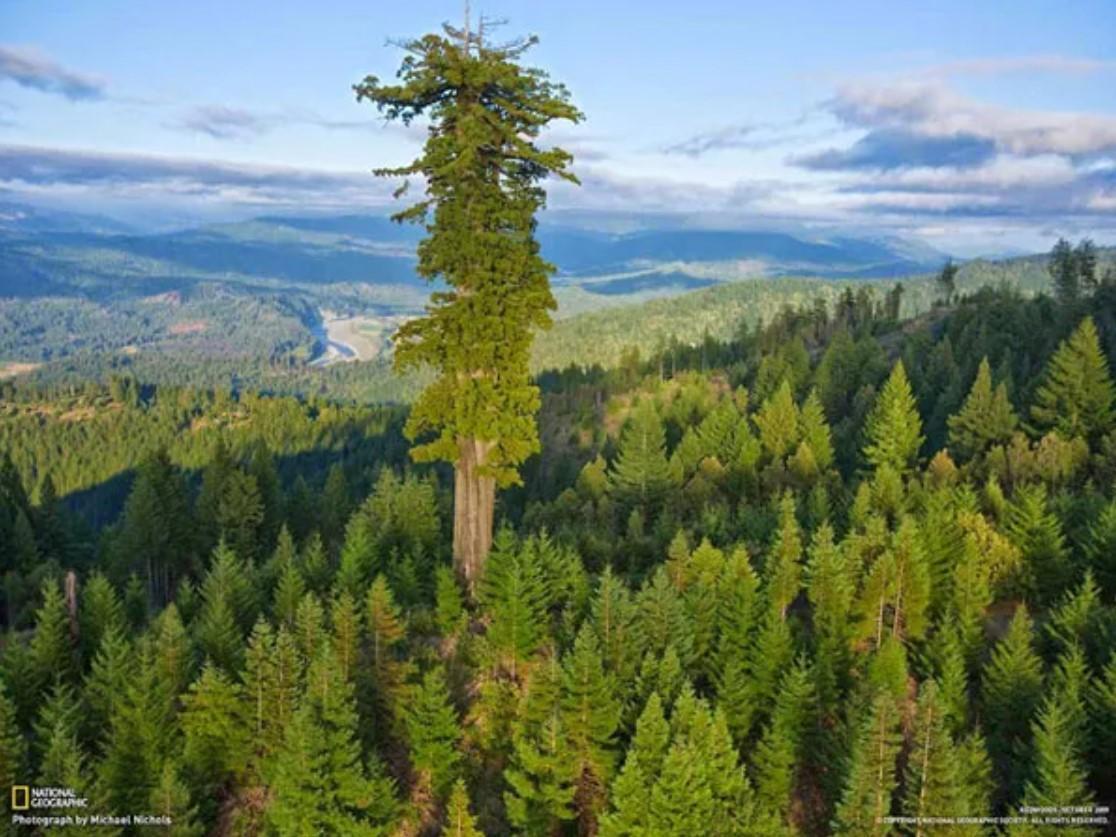What is the Tallest Tree in the World?


Have you ever imagined a tree towering as high as a 35-story building? These natural giants do exist, although their canopies often reach above the clouds, hidden in remote and hard-to-reach places. While many trees grow to impressive heights, one stands above the rest as the tallest living being on Earth. Found in specific regions, primarily in North America and Australia, these colossal trees achieve their extraordinary height due to a unique combination of environmental factors and natural adaptations.
In this article by thedailyECO, we'll explore the world's tallest trees, uncovering their remarkable characteristics and the factors behind their record-breaking growth.
What is the tallest giant tree in the world?
Let's begin by introducing the world's tallest tree: Hyperion, a coast redwood (Sequoia sempervirens). Standing at an astonishing 115.85 meters (380 feet), it holds the record as the tallest known living organism on Earth. While its trunk measures 4.84 meters in diameter, other redwoods may surpass it in width, but none exceed its impressive height.
Hyperion is estimated to be around 600 years old and was discovered in 2006 by a group of hikers exploring the park. Its name is inspired by Hyperion, the Titan from Greek mythology, reflecting its towering stature.
Where is the tallest tree in the world?
If you're wondering where this giant can be found, Hyperion resides in Redwood National Park in northern California, USA. However, its exact location remains a well-guarded secret, known only to select biologists and park rangers to protect the tree from potential damage.
As a species, the coast redwood is an evergreen, retaining its foliage year-round. Native to California, these trees thrive in humid environments at elevations up to 900 meters (3,000 feet). The redwood's name comes from its thick trunk, covered in bark that sheds reddish plates. Known for their remarkable longevity, these trees can live over 1,000 years and grow at a rapid pace of approximately 1.8 meters (6 feet) per year.
If you're fascinated by nature's giants, you'll love learning about the world’s oldest tree.

What is the largest tree in the world?
While Hyperion is renowned as the world's tallest tree, the General Sherman Tree holds a different distinction: it's the largest known living single-stem tree by volume.
Located in Sequoia National Park, California, General Sherman is a giant sequoia (Sequoiadendron giganteum), not a coast redwood. Despite being slightly shorter than Hyperion at 83.8 meters (275 feet), its massive trunk, measuring approximately 11 meters (36 feet) in diameter at the base, gives it an impressive volume of 1,487 cubic meters (52,508 cubic feet).
Estimated to be between 2,200 and 2,700 years old, General Sherman is also one of the oldest living organisms on Earth. While there are ancient bristlecone pines in the White Mountains of California that are estimated to be over 4,800 years old, they are not single-stem trees like the General Sherman.
What are the top 5 tallest trees in the world?
Hyperion hasn’t always held the title of the tallest tree in the world. Over the years, several other towering giants have vied for the top spot. Let’s take a look at some of these notable contenders:
1. Helios
Following Hyperion, Helios is currently the second tallest tree on record, standing at 114.58 meters (375.9 feet). Like Hyperion, it belongs to the coast redwood (Sequoia sempervirens) species and is located in Redwood National Park, California.
2. Icarus
Another coastal redwood, Icarus, rises to a height of 113.14 meters (370 feet). It was discovered the same year as Hyperion in 2006, also within Redwood National Park.
3. The Stratosphere Giant
Before the discovery of Hyperion, the Stratosphere Giant held the title of the tallest tree in the world. With a height of 113.11 meters (371.1 feet), this redwood also resides in a hidden location within Redwood National Park. Notably, it has the largest trunk diameter among these tall redwoods, measuring 5.18 meters (17 feet).
4. Fusion Giant
Once recognized as the tallest tree in the world until 1995, the Fusion Giant reaches 112.71 meters (369.8 feet). Its exact location is unknown, but it is likely found within Redwood National Park, like the others.
All of these trees are from the Sequoia sempervirens species, and their exact locations are often kept secret to protect them from human interference. Each has, at one time or another, been considered among the tallest living trees, reflecting the remarkable growth potential of these ancient giants.
If you're fascinated by towering trees, you'll love learning more about why trees are so crucial to our planet in this related article.
What makes these trees grow so tall?
The immense height of trees like the coast redwoods is the result of a combination of evolutionary adaptations and environmental factors. Several key reasons contribute to why these trees grow so tall:
Favorable climate conditions:
Redwood forests, particularly in northern California, benefit from a unique climate characterized by heavy winter rains and consistent summer fog. The fog provides moisture to the trees during the dry season, reducing water loss through transpiration (the process of water evaporation from leaves). This helps the trees sustain growth without the stress of drought.
These regions also have relatively mild temperatures year-round, which allows the trees to maintain growth for extended periods without experiencing temperature extremes that could limit their development.
Efficient water transport system:
The internal structure of redwoods and sequoias is incredibly efficient at transporting water from their roots to their towering heights. They possess highly specialized xylem (the tissue responsible for water transport), which can push water up to extraordinary heights through capillary action, cohesion, and transpiration pull. In addition to pulling water from the ground, redwoods are able to absorb moisture directly from fog through their leaves and bark. This “fog drip” supplements the water supply, allowing the trees to survive and thrive even in dry summer months.
Long lifespan:
Both coast redwoods and giant sequoias have extremely long lifespans, often exceeding 1,000 years. With such a long period to grow, these trees accumulate height over centuries, gradually reaching impressive sizes. Despite their size, these trees grow at a moderate pace. This long, slow growth contributes to their strength and longevity, allowing them to build massive trunks capable of supporting extreme heights.
Resistance to diseases and pests:
These trees have evolved with natural resistance to diseases, pests, and even fire. Their thick, fibrous bark contains tannins that make them resistant to insect attacks and fungal infections. This durability allows the trees to live longer and grow taller without succumbing to environmental threats.
Fire adaptations:
Fire, while destructive to many species, actually benefits giant sequoias and coast redwoods. Their thick bark protects them from most fires, and periodic low-intensity fires clear out competing vegetation, allowing them more access to resources like light and nutrients. Fires also help with seed dispersal, especially for sequoias, by opening their cones and preparing the soil for germination.
Access to sunlight
In dense forests, trees that can grow taller than their neighbors have better access to sunlight, which is essential for photosynthesis. The towering height of redwoods and sequoias ensures that they can outcompete other species for light, which is a critical resource in forest ecosystems. Furthermore, the shape of the trees, with a narrow crown at the top, allows them to maximize exposure to sunlight while minimizing the energy spent on producing large branches low on the trunk.
Roots:
Although coast redwoods don’t have very deep roots, they compensate by having a widespread root system that can stretch out over 100 feet from the base of the tree. This extensive root network helps anchor the trees and provides access to nutrients and water. Additionally, their roots interlock with those of nearby trees, further stabilizing them.
Want to understand what makes trees grow so tall? Dive into the essential parts of plants and how they work together in our next article.
If you want to read similar articles to What is the Tallest Tree in the World?, we recommend you visit our Facts about nature category.
- Red Lists of the International Union for Conservation of Nature. Coast redwood (Sequoia sempervirens ). Website: https://www.iucnredlist.org/






